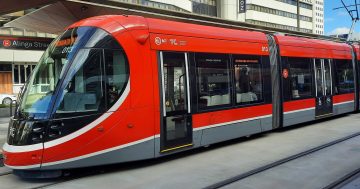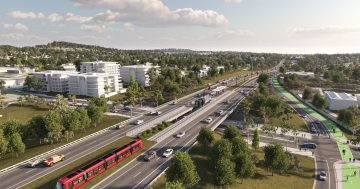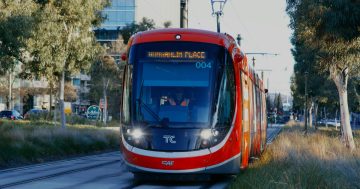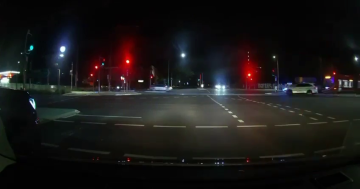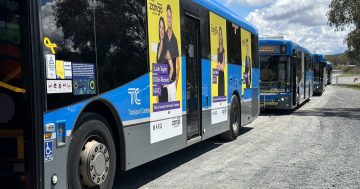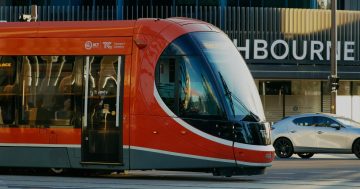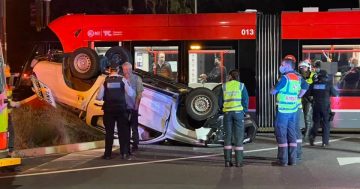
It’s clearly a polarising question in the lead up to the ACT election, the future direction of public transport in Canberra. The Canberra Liberals are staking their election chances on outright opposition to light rail (it’s not a tram, just to be clear Mr Hanson), and have proposed to effectively provide more of the same. Wider roads, more buses, with maybe a couple of bike paths. Labor and the Greens on the other hand promise to extend light rail across the city as a high capacity ‘spine’ for an integrated bus/light rail public transport network.
So what’s the better option? You’ll get no argument from this author that as a pure transport policy, buses are the cheaper way to provide immediate effects for commuters on the existing road system. So why, I hear people ask, did the Barr government decide to invest in the more expensive, fixed transport option? For me, it all comes down to land use, and human behaviour.
In case you didn’t know, Canberra has a problem with car dependency. We have the highest Vehicle Kilometres Travelled (VKT) per capita in the country, and over 82% of us commute to work by driving. Our urban form makes it nearly impossible to get by without a car. If you doubt it, ask yourself what you’d do if tomorrow you lost your ability to drive. Now think about a person living in Banks, Duffy, MacGregor, or Casey.
The problems associated with urban sprawl, exactly the problems our city has, are not disputed by any rational observer. Canberra’s low urban density, vast single use suburbs spread out like carpet into the distance, extensive road networks and car parks, and large scale retail complexes are the types of land use which produce our high VKT and resultant congestion, energy use, and emissions.
Then there are massive economic drawbacks. It costs an average of $12,000 a year to run a car for individuals, most of which is not returned to the local economy, while the government pours hundreds of millions of dollars a year into road construction and upkeep. This is an expenditure road users come nowhere close to funding, so inevitably it is the ratepayers of Canberra who pay. Additionally, each new suburb that we build piles on the requirement for the territory to not only maintain existing infrastructure, (power, water, sewerage, parks & gardens etc), but to construct and maintain the required new infrastructure. Spreading this compounding liability over a sparsely populated tax base logically results in a higher cost per rate payer.
So what do we do about it? We work to find a way to change land use that encourages better use of existing infrastructure, eliminates car dependency, and encourages ‘trip localisation’, ie creating places where residents can access services locally by walking to it. Light rail, in case examples from all over the world, is a proven mechanism for anchoring Transit Oriented Developments (TOD) which are typically mixed use and walkable. TOD encourages more efficient land use through greater urban density, and a focus on functional design that people react to in a positive way.
And this leads to the next point. While some people point out that a Bus Rapid Transit (BRT) system would be cheaper to build and result in the same change to land use, the evidence doesn’t support the claim. People are not mathematical constants. You cannot look at passenger numbers on a bus-only transport system and automatically translate that across to a future light rail option. When the Gold Coast light rail commenced operation in 2015, public transport usage overall increased 22.6%. An extension to the light rail in Adelaide saw an increase in patronage of 39% in its first week, and when a new light rail line opened in the US city of Minneapolis, a full 40% of riders professed to never having used public transport in the past. This author’s own wife refuses to ride a bus, but was an avid user of the Sydney train network when we lived there. People will, and do, go out of their way to use rail based public transport over road based.
A lot of this behaviour has to do with the urban amenity supported by an electrically powered, wide & low floored, high capacity transit system that can deliver large numbers of people directly into a pedestrianised environment. It is far more comfortable to walk beside a light rail line in the city than it is a road capable of carrying the same amount of people as that line. Picture George Street in Sydney and the enormous noise problems and danger of being hit by a truck if you step off the curb, compared to Bourke Street in Melbourne. It’s not hard to see why Sydney is moving to emulate Melbourne in this respect.
Oh, but what about self-driving cars I hear people ask. I ask this in return: How does a continuous stream of individual vehicles on roads which are now completely hostile to pedestrians promote urban amenity, so necessary for changing land use habits? Where do we park these vehicles? How do autonomous vehicles move a crowd of 15,000 people away from Canberra stadium after a rugby game? How do we power these thousands of vehicles? Autonomous vehicles have their place, but it isn’t in the role of efficient mass transit which is what light rail is all about.
When the clear benefits to the urban environment that light rail can produce are taken into consideration, it becomes increasingly frustrating to listen to the continuing opposition from certain elements of the Canberra community. What’s more frustrating for this author is the fact that a party who would seek to be our government are promising to reverse the project despite the clear economic, social and environmental benefits.
To accept the current land use/transport status quo is regressive. It denies there’s a problem, shows zero vision for a more liveable city, and exposes their position to inconsistency with reality. How, for example, are they going to pay $300 million in penalties for scrapping the light rail and build better schools and hospitals all while lowering our rates? When are we going to see some bipartisan support for evidence based public transport and land use policy?
I guess that depends on what we all say on the 15th of October.
This article was first published on the ACTlightrail.info website here.












